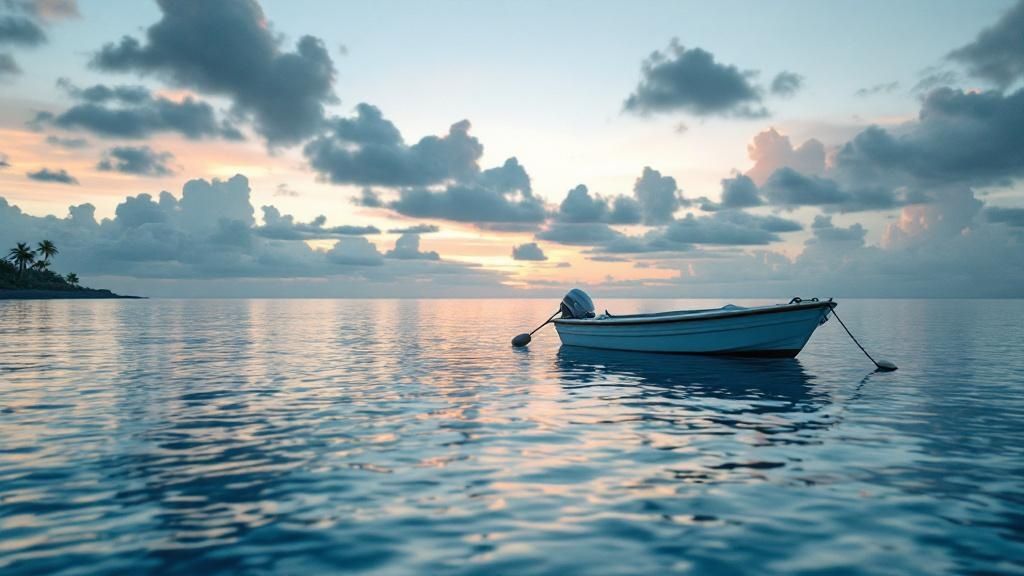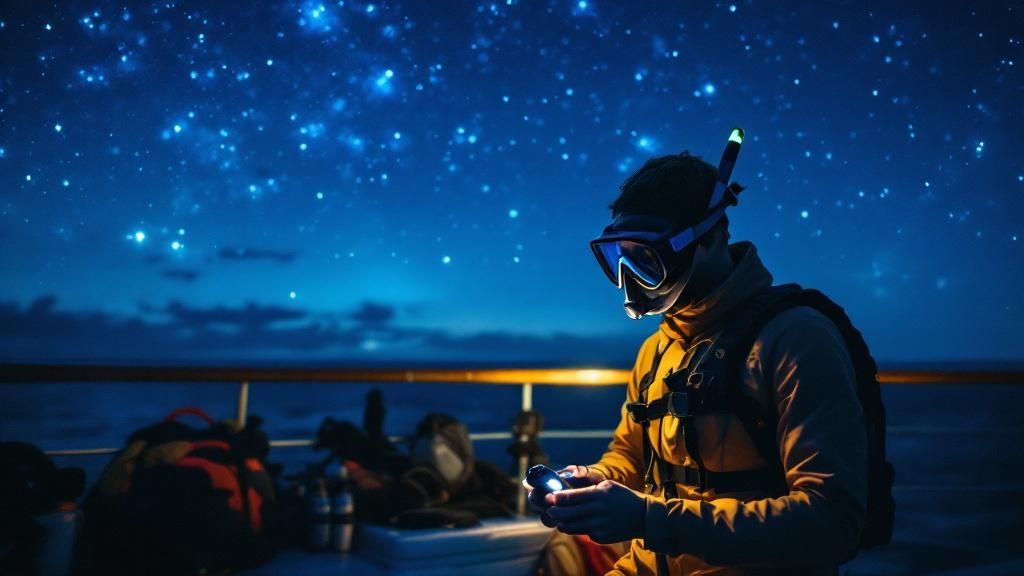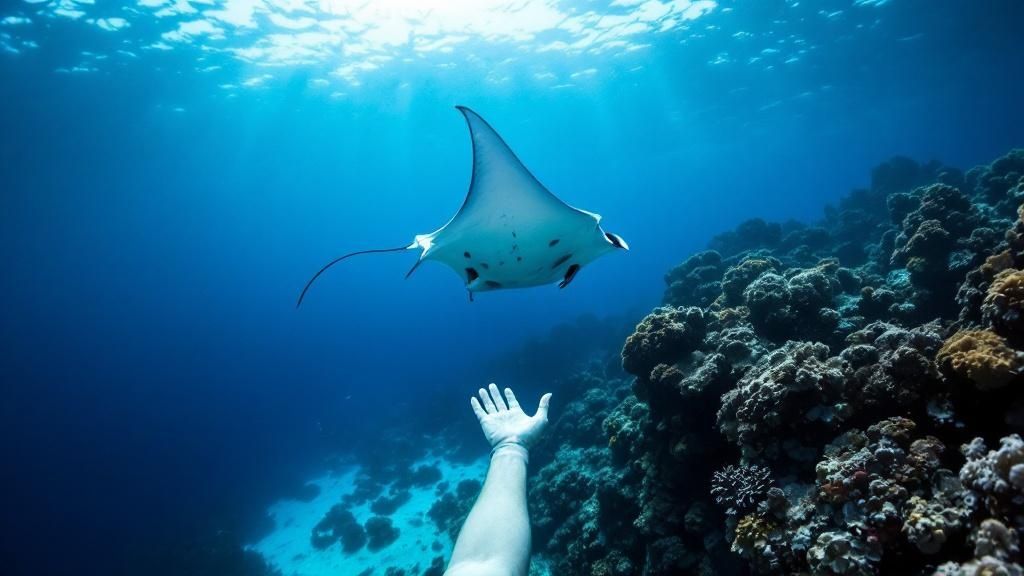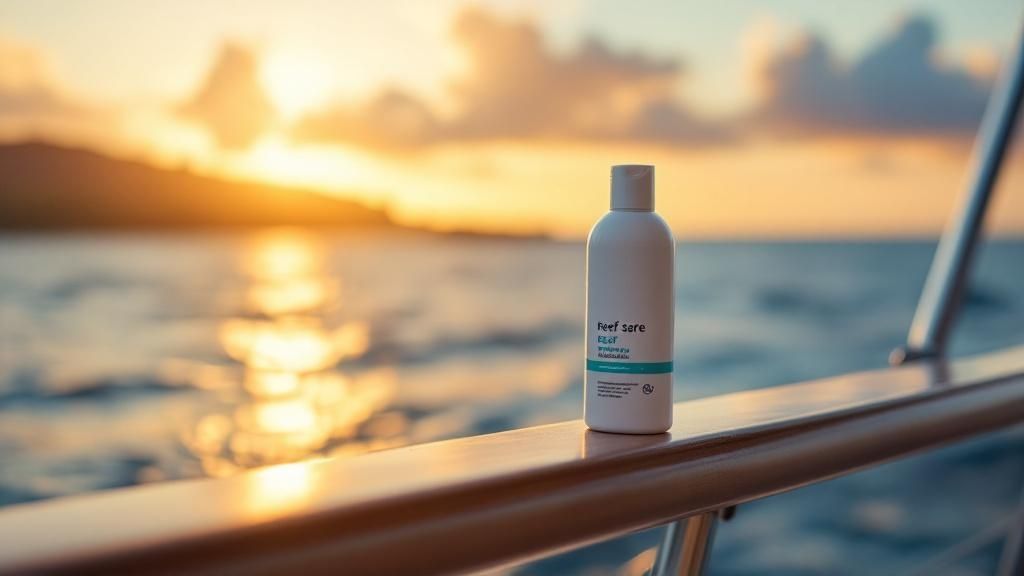Manta Ray Snorkel Big Island: Ultimate Guide for an Unforgettable Experience
- Byron
- Jul 16
- 14 min read
Picture this: you're floating on the calm, dark surface of the Pacific Ocean. Below you, giant, gentle manta rays swoop and glide through illuminated water, performing a silent, graceful ballet. This isn't just a dream; it's the very real, once-in-a-lifetime experience of a manta ray snorkel on the Big Island. With the experts at Manta Ray Night Snorkel Hawaii, you can see for yourself why this is hailed as one of the world's greatest marine encounters.
As a top-rated tour operator, we at Manta Ray Night Snorkel Hawaii are proud of the unforgettable experiences we create for our guests.
Discover the Underwater Magic of Kona
The Kona coast of Hawaii’s Big Island is more than just another beautiful shoreline—it's the world's most famous stage for manta ray encounters. So, what makes this specific spot so magical? It’s all about the perfect storm of geography and biology that creates a spectacular show nearly every single night.
The island's volcanic history has created sheltered bays filled with nutrient-rich water. These conditions are the perfect breeding ground for plankton, which happens to be the manta rays' favorite meal. Over the years, tour operators have figured out how to use this to our advantage. After sunset, they shine powerful, eco-friendly lights into the water, which attracts huge clouds of plankton. It’s like setting up an all-you-can-eat buffet for these gentle giants, and they happily show up for dinner.

A Reliable and Awe-Inspiring Adventure
You might be wondering, "Will I actually see any mantas?" The answer is almost certainly yes. The Kona Coast has one of the highest manta ray sighting rates in the world, hovering between 85% and 90% year-round. It's this incredible consistency that brings around 80,000 people here every year for this experience, making it a top-tier global adventure. You can dive deeper into these incredible manta ray statistics on konahonudivers.com.
This isn't just another snorkeling trip; it's a front-row seat to one of nature's most graceful performances. You'll hold onto a custom-built light board, floating effortlessly as manta rays with wingspans up to 16 feet perform mesmerizing barrel rolls just inches beneath you.
What Makes This Experience So Unique?
Unlike a lot of wildlife tours where you might get a fleeting glimpse from a distance, the manta ray night snorkel is incredibly intimate. And the best part? It's a passive experience. You aren't chasing the animals; they come right to you, drawn by the light and the food. This respectful approach means the mantas aren't stressed, allowing them to feed naturally and creating a safe, unforgettable interaction for everyone.
Gentle Giants: Manta rays are filter feeders. They have no teeth, barbs, or stingers, making the encounter completely safe.
Expert Guidance: Your tour is led by certified guides who give you a full rundown on manta ray biology and all the safety rules before you get in the water.
All-Inclusive Gear: Don't worry about packing gear. Tours provide everything you need, including wetsuits, masks, snorkels, and flotation devices.
This is just a taste of what makes this trip so incredible. If you're ready to see the magic for yourself, you won't want to wait to book your spot.
Why Kona Is the Best Place in the World for Manta Ray Encounters
So, what makes the Kona coast the undisputed champion for manta ray encounters? It's not just a lucky accident. The secret is a perfect storm of unique geology and a thriving marine ecosystem. The Big Island's volcanic past has carved out an underwater landscape that seems almost designed for these gentle giants, making the manta ray snorkel Big Island tour one of the most reliable and breathtaking wildlife experiences you can find anywhere on Earth.
As a local operator, we at Manta Ray Night Snorkel Hawaii see it every night—the sheer awe on our guests' faces. These sightings are incredibly consistent. But don't just take our word for it:
It all starts with the coastline itself. The calm, sheltered bays, formed by ancient lava flows, act as a shield against the rough currents of the open ocean. Just as importantly, the volcanic rock leaches nutrients into the water, creating the perfect breeding ground for microscopic plankton—the manta rays' favorite food.

The Underwater Ballet: A Natural Spectacle
This abundance of plankton is the main draw. Manta rays are filter feeders, and over the decades, they've learned something amazing. They've figured out that the bright, eco-friendly lights used by tour boats attract a massive plankton feast right to the surface.
Think of it like a floating, all-you-can-eat buffet. The light draws in the plankton, and the mantas simply show up for an easy, reliable meal. It’s a beautiful, symbiotic relationship.
This nightly gathering has been nicknamed the "underwater ballet," and for good reason. You'll watch as these huge, graceful creatures glide through the light beams, performing effortless barrel rolls and somersaults to scoop up as much food as they can. It's an incredible display of natural behavior happening just inches below you as you float safely on the water's surface.
Unmatched Consistency and Clarity
While you might spot manta rays in other places around the globe, nowhere else offers the consistency you'll find in Kona. The mantas here are a resident population, meaning they live here year-round instead of migrating through. This is why the success rate for a manta ray snorkel Big Island tour is so incredibly high.
On top of that, Kona is famous for its exceptionally clear water, which makes the experience even better. Even at night, the visibility is often so good that you can see every elegant movement in stunning detail. Other manta habitats can be seasonal or hit-or-miss, but Kona’s consistent plankton blooms keep the mantas coming back every single night. You can dive deeper into why Kona is a premier spot for marine adventure on our Manta Ray Night Snorkel Hawaii blog.
It’s this special combination of factors that sets Kona apart:
Volcanic Topography: Creates calm, sheltered bays that are perfect for plankton.
Resident Population: The manta rays are here 365 days a year.
Established Feeding Sites: A learned behavior that makes sightings almost guaranteed.
Exceptional Water Clarity: Gives you a crystal-clear, front-row seat to the show.
Together, these elements create an experience that’s not just magical, but also wonderfully dependable. It's a natural phenomenon, helped along by responsible tour operators, that allows thousands of people to witness one of the ocean's greatest spectacles. Ready to see it for yourself?
How to Prepare for Your Manta Ray Snorkel Adventure
A little preparation goes a long way in turning a great trip into a truly unforgettable one. Knowing what to expect and what to pack means you can leave any worries on shore and just soak in the magic of the underwater ballet you're about to witness.
This section is all about the practical side of things. If you're looking for a more in-depth look at the entire experience, be sure to check out our manta ray snorkel Big Island ultimate guide when you're done here.

Reputable tour operators like Manta Ray Night Snorkel Hawaii will have all the big stuff covered. We provide high-quality masks, snorkels, fins, and even wetsuits to keep you perfectly comfortable in the ocean. We also supply flotation devices—think pool noodles or custom-built light boards—so you can float with zero effort and just enjoy the show.
That said, a few personal items can make your experience that much smoother. A little planning now ensures you’ll be comfortable for the entire trip, from start to finish.
Your Manta Ray Snorkel Checklist
To make things super simple, here's a quick checklist. This table breaks down what you should toss in your bag versus what we’ll have ready for you on the boat.
What to Bring | What We Provide | Helpful Tip |
|---|---|---|
Swimsuit | Wetsuit | Wear your swimsuit under your clothes to save time. |
Towel | Mask & Snorkel | A quick-dry towel is perfect for the boat. |
Dry Clothes | Fins | A dry change of clothes makes the ride back much cozier. |
Light Jacket | Flotation Device | It can get breezy on the water after your swim. |
Reef-Safe Sunscreen | Expert Guides | Apply before a sunset tour to protect your skin and our reefs. |
Bringing these simple items means your comfort is taken care of. You can fully immerse yourself in the moment when the mantas appear, without any pesky distractions.
Easing Common Worries
It’s totally normal to have questions, especially if this is your first time snorkeling at night. Let’s tackle a couple of the most common concerns right now so you can feel completely at ease.
First up: water temperature. The Pacific waters around Kona are pretty warm year-round, but they can feel a bit cooler after the sun goes down. That’s exactly why we provide wetsuits! They do a fantastic job of keeping you warm and also add a bit of buoyancy, making it even easier to float.
Another common one is seasickness. If you know you’re prone to motion sickness, it’s a smart move to take an over-the-counter remedy before you get on the boat. The focus should be on the incredible marine life, not an uneasy stomach.
Once these small details are handled, you’re all set for an incredible night. All that’s left to do is get excited for one of the most unique wildlife encounters you'll ever have.
What to Expect During Your Underwater Ballet
Your adventure starts just as the Hawaiian sun kisses the horizon, setting the sky ablaze in fiery oranges and pinks. There's a special kind of magic in the air as you head out on the boat. The gentle sea breeze and the sound of the waves create a peaceful buzz of anticipation. Honestly, the boat ride itself is incredible, giving you breathtaking views of the Kona coastline as it's bathed in that perfect golden hour light.

Once your crew anchors at one of Kona’s famous manta spots, they get to work. They'll set up the main attraction: a custom-built, floating light board. It’s a brilliant piece of engineering with powerful lights that shine straight down, lighting up the water like a stage and creating a beacon for microscopic plankton.
You can think of it like setting the dinner table for the ocean's most graceful giants. The light board essentially attracts a massive cloud of plankton, creating a floating, all-you-can-eat buffet. It's a simple, genius technique, and it's the secret sauce behind the ridiculously high success rate of seeing mantas here.
Your Front-Row Seat to the Show
After a quick but thorough safety briefing, it's time to slip into the warm, dark water. You’ll be wearing a wetsuit to stay comfortable, and you'll have a flotation device—usually built right into the light board itself. All you have to do is hold on, float effortlessly, and put your face in the water.
This setup is perfect. It’s stable, it’s secure, and it lets you watch the whole spectacle unfold without disturbing a thing. No swimming is required. You’re just a quiet observer, perfectly positioned for a front-row seat to one of the most amazing shows on Earth.
The moment that first manta ray appears is pure magic. One second there's nothing, and the next, a giant, shadowy figure glides out of the deep blue and into the light. It's a humbling, awe-inspiring sight that usually leaves people completely speechless.
These gentle giants can have wingspans of up to 16 feet, yet they move with a grace that seems impossible for their size. They perform mesmerizing barrel rolls and elegant somersaults, sometimes just inches below you, with their huge mouths wide open to filter the plankton. You're witnessing their natural feeding behavior—a captivating underwater ballet that's both educational and deeply moving.
A Reliable and Well-Studied Phenomenon
This incredible nightly gathering isn't just some random fluke; it's a well-documented natural phenomenon. Scientists have been studying the manta rays along the Kona Coast for years, giving us amazing insights into their world. Between 2009 and 2014, for example, researchers kept detailed nightly records at sites like Manta Village and Manta Heaven. These studies confirmed a resident population of over 450 individual mantas and proved just how consistently they show up. You can dive deeper into the data over at MantaRayAdvocates.com.
This research is exactly why the manta ray snorkel Big Island experience is so dependable. You're watching a predictable, natural behavior that has been happening for decades. The entire encounter is on their terms. They come for the food, and we're just lucky enough to be invited to watch. It truly gives you a profound respect for these animals, reminding you that you're a guest in their world.
Ready to book your front-row seat for this incredible underwater ballet?
Keeping the Manta Encounter Safe and Magical
Seeing a manta ray up close is more than just a vacation highlight—it’s a powerful connection with the natural world. But with that privilege comes a big responsibility: we have to protect these gentle giants and their ocean home. Responsible tourism is what makes this whole incredible experience possible, ensuring the mantas are here for many more generations to enjoy.
Here at Manta Ray Night Snorkel Hawaii, this isn't just a rulebook for us; it's our core philosophy. The glowing reviews from our guests are a testament to our commitment to a safe, respectful, and truly unforgettable encounter.
If you remember only one thing, make it this: do not touch the manta rays. It's the golden rule, and it's absolutely critical for their health. Manta rays have a special, slimy coating on their skin that acts like their immune system, protecting them from nasty bacteria in the water.
Think of it like a protective force field. When you touch a manta, you wipe off that mucus, leaving them vulnerable to infections. It's like giving them an open wound. Simply keeping your hands to yourself is one of the most direct ways you can help keep the local manta population healthy.
Guidelines for a Respectful Swim
To make sure the experience is amazing for you and stress-free for the mantas, every good tour operator follows a clear set of rules. These guidelines are all about minimizing our footprint and letting the mantas go about their business. They’re simple to follow and make the whole night run smoothly.
For a detailed look at what to expect from start to finish, you can check out our **complete journey guide** for the manta snorkel. Following these simple rules is how we all work together to preserve this one-of-a-kind natural wonder.
Here’s a quick rundown of the do's and don'ts to ensure everyone—human and manta—has a great time.
Manta Ray Interaction Guidelines Do's and Don'ts
Guideline | Do | Don't |
|---|---|---|
Observation | Observe passively and let the mantas come to you. | Don't chase, grab, or attempt to "pet" the mantas. |
Positioning | Stay on the surface and hold onto your flotation device. | Don't dive down into the water where the mantas are feeding. |
Lights | Keep your lights pointed down to attract plankton. | Don't shine your light directly into a manta's eyes. |
Movement | Remain as still as possible to create a calm environment. | Don't splash or make sudden movements that could startle them. |
Sticking to these guidelines is easy, and it makes all the difference in protecting the mantas and their feeding grounds.
Why Choosing the Right Tour Operator Matters
Picking a tour operator that genuinely cares about these standards is crucial. A responsible company isn’t just a water taxi to the manta site; they are guardians of this precious ecosystem. They’ll give you a thorough safety briefing, enforce the rules on the water, and teach you why conservation is so important.
When you book with a tour that puts the mantas' well-being first, you become part of the solution. Your ticket helps support sustainable tourism, which in turn funds research, protection efforts, and the local community. Your adventure becomes a meaningful act of conservation, ensuring this underwater ballet continues to dazzle for years to come.
Got Questions About Your Manta Ray Snorkel? We’ve Got Answers.
It’s totally normal to have a few questions before you jump into a new adventure, no matter how exciting it is. We've heard just about every question you can think of, and we're here to give you clear, simple answers so you can feel completely ready for your manta ray snorkel Big Island experience.
Let's walk through the most common questions we get. Our goal is to put your mind at ease so that when you’re out on the water, all you have to do is soak in the magic. At Manta Ray Night Snorkel Hawaii, we know that a prepared snorkeler is a happy snorkeler—and our guest reviews show how much we care about making your trip incredible from start to finish.
Is It Safe to Swim with Manta Rays?
This is the number one question we get, and the answer is a big, confident yes, it is absolutely safe! People often mix up manta rays with their cousins, the stingrays, but they couldn't be more different.
Manta rays have no teeth, no stingers, and no barbs. They are true gentle giants, filter-feeding on microscopic plankton. They’re curious about people but pose no threat. You’ll just be floating peacefully on the surface while they glide and dance below you, completely focused on their plankton buffet.
Do I Need to Be a Strong Swimmer?
Not at all. That’s one of the best things about this experience! You'll be given excellent flotation gear, like a pool noodle or a custom light board that you simply hold onto.
The whole activity is passive. You just float, hold the board, and look down into the water. No actual swimming is required, which makes this adventure perfect for people of all ages and fitness levels.
What If I Have Never Snorkeled Before?
No worries! The manta ray snorkel Big Island tour is an ideal first-time snorkeling experience. Before you even touch the water, your guides will give you a full rundown on how to use the gear—the mask, snorkel, and fins—and what to expect.
It's a calm, controlled setting, and you'll be with a group under the careful watch of certified guides. It’s a super safe and supportive way to give snorkeling a try.
What Is the Difference Between the Snorkel and the Dive?
It really comes down to your vantage point in the water.
Snorkelers: You float on the surface, holding a special light board. The lights shine down, attracting plankton and drawing the mantas right up to you. You get a top-down view of the show just inches away.
Divers: Certified SCUBA divers head to the ocean floor, usually around 25-35 feet deep, and shine their lights up. They get to look up as the mantas swoop and barrel-roll above them.
Both experiences are incredible, but snorkeling is far more accessible since it doesn't require any certification. You still get a breathtaking, front-row seat to all the action.
Is There a Manta Ray Season?
Nope! And that's fantastic news. The mantas off the Kona coast are a resident population, which means they live here all year long. They don’t migrate, so they reliably show up for their nightly plankton feast.
This means any time you visit the Big Island is a great time to see the mantas. The show is just as spectacular in July as it is in January.
How Likely Am I to Actually See Manta Rays?
Your chances are incredibly high. The sighting success rate is consistently around 90% or more. While no wildlife encounter is ever a 100% guarantee, this is one of the most dependable in the world. The mantas have been drawn to these lights for decades, so it’s a well-established dinner bell for them.
In the rare case that no mantas show up, most reputable tour operators offer a "manta guarantee." This usually means you can come back another night for free. It’s a good reason to book your snorkel tour early in your vacation, just in case you need that second chance!
What Should I Do If a Manta Ray Touches Me?
This is a great question, especially with the "no touching" rule. While you should never, ever reach out to touch a manta, they are curious creatures and sometimes glide very close.
If one happens to brush against you, the best thing to do is stay perfectly still and calm. Don't panic or splash around. Just enjoy the awe-inspiring moment. The "no touching" rule is all about us not initiating contact, which helps keep them safe.
Want to learn more? Check out our ultimate experience guide to the Kona manta ray night snorkel.
Frequently Asked Questions
Have a few more quick questions? This table has you covered with fast answers to the most common things people ask.
Question | Answer |
|---|---|
Is it safe to swim with Manta Rays? | Yes! They have no stingers, barbs, or teeth and are gentle filter-feeders. |
Do I need to be a strong swimmer? | No. You will hold onto a flotation device and float effortlessly on the surface. |
What if I've never snorkeled before? | It's perfect for beginners. Guides provide a full briefing and support. |
Is there a Manta Ray "season"? | No. The resident manta population is here year-round, making any time a good time. |
What happens if we don't see any mantas? | Most companies offer a "manta guarantee" to re-book your tour for free. |
Can I get seasick? | It's possible. If you are prone to motion sickness, take preventative measures beforehand. |
How cold is the water? | The water is warm, but we provide wetsuits to ensure you stay comfortable for the entire time. |
Hopefully, that clears everything up! Getting ready for this adventure is part of the fun, and now you’re one step closer to witnessing one of the most magical underwater shows on Earth. This isn't just another tour—it's a memory you'll hold onto forever.
Ready to experience the magic for yourself? Join Manta Ray Night Snorkel Hawaii for an unforgettable evening with these gentle giants. Our expert guides, small group sizes, and commitment to safety ensure you have the best possible experience.
Comments